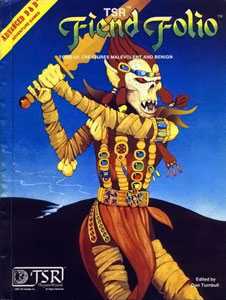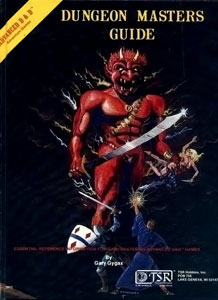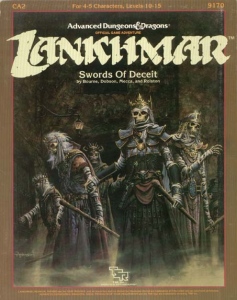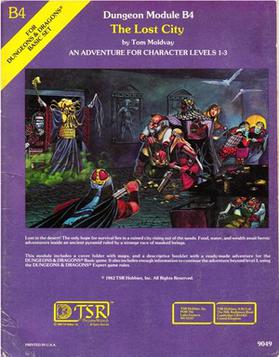 | |
| Genre | Role-playing game |
|---|---|
| Publisher | Wizards of the Coast |
Publication date | 2004 |
| Media type | |
| ISBN | 0-7869-3134-5 |
The Map Folio series consists of three supplements to the 3.5 edition of the Dungeons & Dragons role-playing game.
 | |
| Genre | Role-playing game |
|---|---|
| Publisher | Wizards of the Coast |
Publication date | 2004 |
| Media type | |
| ISBN | 0-7869-3134-5 |
The Map Folio series consists of three supplements to the 3.5 edition of the Dungeons & Dragons role-playing game.
Map Folio I contains 32 full-color maps originally developed for the Map-a-Week feature on the official D&D website.
Map Folio II contains 32 all-new full-color maps.
Map Folio 3-D contains a small village of highly detailed card-stock buildings, walls, and other structures for assembly and use in any game. The buildings are scaled for use with Dungeons & Dragons Miniatures.
Map Folio I was illustrated by Todd Gamble and Robert Lazzaretti, and published in 2004. Map Folio II was illustrated by Todd Gamble, and published in 2004. Map Folio 3-D was designed by Dennis Kauth and Todd Gamble, and published in December 2004.

The Monster Manual is the primary bestiary sourcebook for monsters in the Dungeons & Dragons fantasy role-playing game, first published in 1977 by TSR. The Monster Manual was the first hardcover D&D book and includes monsters derived from mythology and folklore, as well as creatures created specifically for D&D. Creature descriptions include game-specific statistics, a brief description of its habits and habitats, and typically an image of the creature. Along with the Player's Handbook and Dungeon Master's Guide, the Monster Manual is one of the three "core rulebooks" in most editions of the D&D game. As such, new editions of the Monster Manual have been released for each edition of D&D. Due to the level of detail and illustration included in the 1977 release, the book was cited as a pivotal example of a new style of wargame books. Future editions would draw on various sources and act as a compendium of published monsters.

Monster Manual II is the title shared by two hardback rulebooks published for different versions of the Dungeons & Dragons (D&D) fantasy roleplaying game.

Fiend Folio is the name of three separate products published for successive editions of the fantasy role-playing game Dungeons & Dragons (D&D). All three are collections of monsters.

The Player's Handbook is a book of rules for the fantasy role-playing game Dungeons & Dragons (D&D). It does not contain the complete set of rules for the game, and only includes rules for use by players of the game. Additional rules, for use by Dungeon Masters (DMs), who referee the game, can be found in the Dungeon Master's Guide. Many optional rules, such as those governing extremely high-level players, and some of the more obscure spells, are found in other sources.

The Dungeon Master's Guide is a book of rules for the fantasy role-playing game Dungeons & Dragons. The Dungeon Master's Guide contains rules concerning the arbitration and administration of a game, and is intended for use by the game's Dungeon Master.

Expedition to the Barrier Peaks is a 1980 adventure module for the Dungeons & Dragons role-playing game written by Gary Gygax. While Dungeons & Dragons (D&D) is typically a fantasy game, the adventure includes elements of science fiction, and thus belongs to the science fantasy genre. It takes place on a downed spaceship; the ship's crew has died of an unspecified disease, but functioning robots and strange creatures still inhabit the ship. The player characters fight monsters and robots, and gather the futuristic weapons and colored access cards that are necessary for advancing the story.

Ravenloft is an adventure module for the Dungeons & Dragons (D&D) fantasy role-playing game. The American game publishing company TSR, Inc. released it as a standalone adventure booklet in 1983 for use with the first edition Advanced Dungeons & Dragons game. It was written by Tracy and Laura Hickman, and includes art by Clyde Caldwell with maps by David Sutherland III. The plot of Ravenloft focuses on the villain Strahd von Zarovich, a vampire who pines for his lost love. Various story elements, including Strahd's motivation and the locations of magical weapons, are randomly determined by drawing cards. The player characters attempt to defeat Strahd and, if successful, the adventure ends.

The Forgotten Realms Campaign Setting is a role-playing game sourcebook first published by TSR in 1987 for the first edition of the fantasy role-playing game Advanced Dungeons & Dragons that describes the campaign setting of the Forgotten Realms. It contains information on characters, locations and history. Various revised and updated editions have been produced over the years.
The World's Largest Dungeon is a Dungeons & Dragons adventure set entirely in an enormous dungeon. It is over 800 pages long and was produced by Alderac Entertainment Group in 2004. It also includes 16 full-color poster maps, making its single tome one of the largest campaign settings in one product.

The Hidden Shrine of Tamoachan is an adventure module for the Dungeons & Dragons (D&D) fantasy role-playing game, set in the World of Greyhawk campaign setting for use with the 1st edition Advanced Dungeons & Dragons rules. It is the first in the C-series of modules, a set of unrelated adventures originally designed for competitive play, with the C representing the first letter in the word competition.
The Draconomicon is the title for several optional sourcebooks for the Dungeons & Dragons role-playing game, providing supplementary game mechanics for dragons specifically. Different Draconomicon books have been issued for the 2nd, 3rd, and 4th editions of the Dungeons & Dragons game. The Latin-inspired name of the books loosely translates as "Book of Dragon Names".
The DL series is a series of adventures and some supplementary material for the Advanced Dungeons & Dragons role playing game. These modules along with the Dragonlance Chronicles trilogy of novels, which follow one possible adventure series through the modules, were the first published items that established the Dragonlance fictional universe. The original DL series was released from 1984 to 1986, with the final two modules added to it in 1988. In the 1990s these roleplaying adventures from the original series were collected and revised for 2nd Edition AD&D as the three DLC Dragonlance Classics modules. There were also versions of the module series released in 1999, 2000 and 2006.
The World of Greyhawk Fantasy Game Setting and the World of Greyhawk Fantasy World Setting are two closely related publications from TSR, Inc. that detail the fictional World of Greyhawk campaign setting for the Dungeons & Dragons (D&D) fantasy roleplaying game. Both publications were authored by Gary Gygax, and they were the first stand-alone offerings to provide detailed, comprehensive information regarding a D&D campaign setting.

Swords of Deceit is a 1986 adventure module for the Advanced Dungeons & Dragons fantasy role-playing game, for the Lankhmar setting.

The Lost City (B4) is a Dungeons & Dragons adventure module by Tom Moldvay. It was first published by TSR in 1982 and was designed as a stand-alone adventure for use with the Dungeons & Dragons Basic Set. The working title for the module was "The Lost City of Cynidicea". Moldvay designed the module as a low-level scenario to give novice Dungeon Masters experience in fleshing out adventures such that it is only partially complete. The plot involves the player characters discovering a ruined subterranean city slowly rising out of the sands. The adventure is set inside a huge step pyramid, with the lower pyramid only sketched out and the city itself described with a list of the major areas and a map. The adventure's main villain is Zargon, a giant one-eyed monster and his minions. The entire double pyramid, not including the city, contains over 100 rooms.

The Ruins of Undermountain is a boxed set for the Forgotten Realms campaign setting for the second edition of the Advanced Dungeons & Dragons fantasy role-playing game. The set was written by Ed Greenwood and published by TSR. It featured box cover art by Brom. and was published in 1991.

The Dungeon Tiles series consists of seven sets of supplementary map grids for the 3.5 edition of the Dungeons & Dragons role-playing game.

The Dungeons & Dragons Adventure Game is the name of two companion accessories to the second and third editions of the Dungeons & Dragons fantasy role-playing game. Designed as simpler, stand-alone versions of Dungeons & Dragons, they feature a simplified ruleset, but with character progression that parallels the standard game. However, for 3rd-level characters and higher, the standard Player's Handbook is still required. The first version was published in 1999 for the second edition of Advanced Dungeons & Dragons, while the second version was published in 2000 for the third edition of Dungeons & Dragons.

Keep on the Shadowfell is the first official product from the 4th edition Dungeons & Dragons ("D&D") line. It is part one of a three-part series of adventures. It introduces a series of 4th edition Dungeons & Dragons settings called the Points of Light, a loosely connected and open-ended series of settings designed to allow other modules and fan-created content to be integrated seamlessly into the settings' largely unmapped fantasy world or the Dungeon Master's own custom-made setting. The adventure, written by Mike Mearls and Bruce R. Cordell, was published in 2008 by Wizards of the Coast. It is followed by the sequels Thunderspire Labyrinth and Pyramid of Shadows. The adventure is designed for characters from levels 1 to 3. Its module code, "H", stands for Heroic Tier. This module is set in a region of the world called the Nentir Vale, which is described in greater detail in the 4th edition Dungeon Master's Guide.

In the Dungeons & Dragons fantasy role-playing game, "monsters" are generally the antagonists which players must fight and defeat to progress in the game. Since the game's first edition in 1974, a bestiary was included along other game manuals, first called Monsters & Treasure and now commonly called the Monster Manual. Described as an "essential" part of Dungeons & Dragons, the game's monsters have become notable in their own right, influencing fields such as video games and fiction, as well as popular culture.